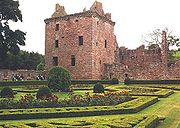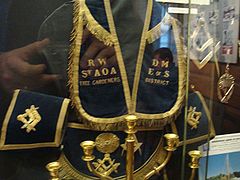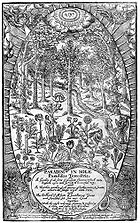
Order of Free Gardeners
Encyclopedia

Scotland
Scotland is a country that is part of the United Kingdom. Occupying the northern third of the island of Great Britain, it shares a border with England to the south and is bounded by the North Sea to the east, the Atlantic Ocean to the north and west, and the North Channel and Irish Sea to the...
in the middle of the 17th Century and later spread to England
England
England is a country that is part of the United Kingdom. It shares land borders with Scotland to the north and Wales to the west; the Irish Sea is to the north west, the Celtic Sea to the south west, with the North Sea to the east and the English Channel to the south separating it from continental...
and Ireland
Ireland
Ireland is an island to the northwest of continental Europe. It is the third-largest island in Europe and the twentieth-largest island on Earth...
. Like numerous other friendly societies
Friendly society
A friendly society is a mutual association for insurance, pensions or savings and loan-like purposes, or cooperative banking. It is a mutual organization or benefit society composed of a body of people who join together for a common financial or social purpose...
of the time, its principal aim was the sharing of knowledge—secrets—linked to the profession and mutual aid. In the 19th Century, its activities of mutual insurance became predominant. By the end of the 20th Century it had become almost entirely extinct.
In 1849, The Ancient Order of Free Gardeners Scotland formed at Penicuik. In 1956, due to falling attendances in Scotland, the Grand Lodge charter was transferred to Cape Town
Cape Town
Cape Town is the second-most populous city in South Africa, and the provincial capital and primate city of the Western Cape. As the seat of the National Parliament, it is also the legislative capital of the country. It forms part of the City of Cape Town metropolitan municipality...
, South Africa and remains there. In September 2005, saw the Ancient Order returned to Scotland when the Countess of Elgin Lodge no. 105 received its Charter to meet in Dysart, Fife.
Although the Free Gardeners always remained independent of Freemasonry
Freemasonry
Freemasonry is a fraternal organisation that arose from obscure origins in the late 16th to early 17th century. Freemasonry now exists in various forms all over the world, with a membership estimated at around six million, including approximately 150,000 under the jurisdictions of the Grand Lodge...
, the history and organisation of the two orders show numerous similarities that shed light on the birth of the latter.
History
The most ancient evidence of the order is a record of the minutes of the HaddingtonHaddington, East Lothian
The Royal Burgh of Haddington is a town in East Lothian, Scotland. It is the main administrative, cultural and geographical centre for East Lothian, which was known officially as Haddingtonshire before 1921. It lies about east of Edinburgh. The name Haddington is Anglo-Saxon, dating from the 6th...
lodge, opened 16 August 1676, which begins with a compilation of fifteen rules called Interjunctions for ye Fraternity of Gardiners of East Lothian
East Lothian
East Lothian is one of the 32 council areas of Scotland, and a lieutenancy Area. It borders the City of Edinburgh, Scottish Borders and Midlothian. Its administrative centre is Haddington, although its largest town is Musselburgh....
.

Masonic Lodge
This article is about the Masonic term for a membership group. For buildings named Masonic Lodge, see Masonic Lodge A Masonic Lodge, often termed a Private Lodge or Constituent Lodge, is the basic organisation of Freemasonry...
.
This organisation set up in Haddington could be viewed as a primitive form of union. It organised cooperation between members, provided practical training and ethical development, and supported the poor, widows, and orphans. The lodges of gardeners were also the first to organise floral exhibitions, from 1772.
About 1715, a lodge similar to Haddington was founded in Dunfermline
Dunfermline
Dunfermline is a town and former Royal Burgh in Fife, Scotland, on high ground from the northern shore of the Firth of Forth. According to a 2008 estimate, Dunfermline has a population of 46,430, making it the second-biggest settlement in Fife. Part of the town's name comes from the Gaelic word...
, supported by two members of the local aristocracy, the Earl of Moray
Earl of Moray
The title Earl of Moray has been created several times in the Peerage of Scotland.Prior to the formal establishment of the peerage, Earl of Moray, numerous individuals ruled the kingdom of Moray or Mormaer of Moray until 1130 when the kingdom was destroyed by David I of Scotland.-History of the...
and the Marquess of Tweeddale
Marquess of Tweeddale
Marquess of Tweeddale is a title of the Peerage of Scotland, created in 1694 for the 2nd Earl of Tweeddale. Lord Tweeddale holds the subsidiary titles of Earl of Tweeddale , Earl of Gifford , Viscount of Walden , Lord Hay of Yester , and Baron Tweeddale, of Yester in the County of Haddington...
. From its origin, it admitted numerous non-gardeners as members. It created a charitable society to benefit the widows, orphans, and poor of the lodge, sponsored a horse race and organised an annual horticultural fair before transforming itself little by little into a mutual aid society. It reached a membership of 212.
The lodges of Haddington and Dunfermline expanded their recruitment area widely without authorising creation of new lodges. It was only in 1796 that three new lodges were created: at Arbroath, Bothwell, and Cumbnathan.
During the 18th Century, about twenty other lodges were created, always in Scotland, and on 6 November 1849, they organized a meeting with a view to create a Grand Lodge. Establishments then accelerated, and in 1859, in Edinburgh
Edinburgh
Edinburgh is the capital city of Scotland, the second largest city in Scotland, and the eighth most populous in the United Kingdom. The City of Edinburgh Council governs one of Scotland's 32 local government council areas. The council area includes urban Edinburgh and a rural area...
, the Grand Lodge gathered representatives from more than 100 lodges, including three established in the USA.
At the peak of the movement there were more than 10,000 Free Gardeners for the Lothians alone, belonging to more than 50 lodges.
Encouraged by this success, competing horticultural societies appeared during the 19th Century. Unlike the Free Gardeners, they did not have a charitable role, mutual help, or rituals, and they would accept anybody, male or female, who paid their dues.

National Insurance Act 1946
The National Insurance Act 1946 was a British Act of Parliament which established a comprehensive system of social security throughout the United Kingdom...
removed their entire purpose. Even before the Second World War, the number of deaths exceeded the number of admissions to the lodges. In 1939, the minutes of the Haddington lodge were interrupted until 1952, when its eight last members attempted in vain to relaunch it. Despite the recruitment of new members, the Haddington fraternity pronounced its dissolution on 22 February 1953. The Dunfermline lodge lasted until the middle of the 1980s.
These disappearances were part of a wider social change. In 1950 there were around 30,000 Friendly Societies in the UK, while in 2000 there were fewer than 150. In 2000, the research of R. Cooper counted no more than a single lodge (in Bristol
Bristol
Bristol is a city, unitary authority area and ceremonial county in South West England, with an estimated population of 433,100 for the unitary authority in 2009, and a surrounding Larger Urban Zone with an estimated 1,070,000 residents in 2007...
) for Great Britain
Great Britain
Great Britain or Britain is an island situated to the northwest of Continental Europe. It is the ninth largest island in the world, and the largest European island, as well as the largest of the British Isles...
, but mentioned the survival of the Order of Free Gardeners in the Antilles
Antilles
The Antilles islands form the greater part of the West Indies in the Caribbean Sea. The Antilles are divided into two major groups: the "Greater Antilles" to the north and west, including the larger islands of Cuba, Jamaica, Hispaniola , and Puerto Rico; and the smaller "Lesser Antilles" on the...
(Caribbean British Order of Free Gardners) and in Australia
Australia
Australia , officially the Commonwealth of Australia, is a country in the Southern Hemisphere comprising the mainland of the Australian continent, the island of Tasmania, and numerous smaller islands in the Indian and Pacific Oceans. It is the world's sixth-largest country by total area...
. In 2002, a conservation society was created in Scotland
Scotland
Scotland is a country that is part of the United Kingdom. Occupying the northern third of the island of Great Britain, it shares a border with England to the south and is bounded by the North Sea to the east, the Atlantic Ocean to the north and west, and the North Channel and Irish Sea to the...
with aims of research and conservation of the traditions of this Order and some lodges were revived on this occasion.
Ritual
Fraternity documents from the end of the 17th century reveal no trace of secret knowledge or rituals. However, the interest rapidly shown by the members of the aristocracy suggests this association did not exclusively deal with mutual assurance.The oldest known mention of the existence of an initiation secret in this order appears on 28 January 1726, when the fraternity studied an internal complaint that accused one of its members of defaming certain of its officers in saying they could not correctly give its words and signs. In 1772, other documents established that the fraternity of the Free Gardeners had 'Words' and 'Secrets'. An 1848 document mentions a teaching, in the form of 'Signs, Secrets and Grips'. Historians have at their disposal complete rituals of the Apprentice, Companion and Master dating from 1930. Minutes of the lodges show that the ritual of the order progressively developed, from a fairly basic ceremony of transmission of the 'Word' at its very beginnings, to a system of three grades similar to that of Freemasonry
Freemasonry
Freemasonry is a fraternal organisation that arose from obscure origins in the late 16th to early 17th century. Freemasonry now exists in various forms all over the world, with a membership estimated at around six million, including approximately 150,000 under the jurisdictions of the Grand Lodge...
at the end of the 19th Century.

Garden of Eden
The Garden of Eden is in the Bible's Book of Genesis as being the place where the first man, Adam, and his wife, Eve, lived after they were created by God. Literally, the Bible speaks about a garden in Eden...
.
- The admission ritual of the Free Gardeners' apprentices shows many similarities to that of Freemason apprentices. Adam could thus symbolically be the first Free Gardener. Use is made of the compass and the square, to which is added the knife, presented as 'the simplest tool of gardening', allowing 'pruning the vices and propagating virtues by cuttings'. At the end of this ceremony, the apprentice received the apron of his grade.
- The second degree made reference to NoahNoahNoah was, according to the Hebrew Bible, the tenth and last of the antediluvian Patriarchs. The biblical story of Noah is contained in chapters 6–9 of the book of Genesis, where he saves his family and representatives of all animals from the flood by constructing an ark...
, the 'second Gardener' and made the Companion symbolically accomplish a voyage that led him towards the Garden of Eden then towards that of GethsemaneGethsemaneGethsemane is a garden at the foot of the Mount of Olives in Jerusalem most famous as the place where, according to Biblical texts, Jesus and his disciples are said to have prayed the night before Jesus' crucifixion.- Etymology :...
.
- The third degree made reference to SolomonSolomonSolomon , according to the Book of Kings and the Book of Chronicles, a King of Israel and according to the Talmud one of the 48 prophets, is identified as the son of David, also called Jedidiah in 2 Samuel 12:25, and is described as the third king of the United Monarchy, and the final king before...
, the 'third Gardener', and to the symbol of the olive tree.
The aprons are of two types:
- Long aprons, reaching the ankle, embroidered with numerous symbols relating to the legends of the order.
- Shorter aprons, with a semi-circular bib, strongly resembling the aprons of the Freemasons of Scotland. That of the president is embroidered with the letters P, G, H, E, initials of the four rivers of the Garden of Eden, and A, N, S, initials of Adam, Noah and Solomon, to which is added the letter O, probably for 'Olive'.
Generally, the symbolism utilized by the Free Gardeners seems to have been strongly influenced during the 19th Century by that of Freemasonry
Freemasonry
Freemasonry is a fraternal organisation that arose from obscure origins in the late 16th to early 17th century. Freemasonry now exists in various forms all over the world, with a membership estimated at around six million, including approximately 150,000 under the jurisdictions of the Grand Lodge...
.
On numerous objects of the order dating from the very beginning of the 20th Century, one finds an emblem composed of a square, a compass and a grafting knife. As there is not a trace of this emblem in the earlier documents, it is probable that it had also been inspired lately by that of Freemasonry.
The first members
There is little information on the professions of the members before the end of the 17th Century. During this period the HaddingtonHaddington, East Lothian
The Royal Burgh of Haddington is a town in East Lothian, Scotland. It is the main administrative, cultural and geographical centre for East Lothian, which was known officially as Haddingtonshire before 1921. It lies about east of Edinburgh. The name Haddington is Anglo-Saxon, dating from the 6th...
lodge included merchants, tailors and clerks as well as gardeners. All the members of the lodge were originally from the county. On the other hand, the lodge at Dunfermline, former capital of Scotland, prided itself on counting among its members 'numerous renowned persons of Edinburgh, as well as East Lothian including the Marquess of Tweeddale, the count of Haddington (Earl of Haddington
Earl of Haddington
Earl of Haddington is a title in the Peerage of Scotland. It was created in 1627 for the noted Scottish lawyer and judge Thomas Hamilton, 1st Earl of Melrose. He was Lord President of the Court of Session from 1616 to 1625...
), Lord William Hay etc.'.
The first record of the Dunfermline lodge was established in 1716 with the signatures of 214 members. At this time the membership was composed of a majority of gardeners by trade, but also numerous artisans and two members of the local aristocracy. Rapidly, the membership grew and the social level rose—to the point that the professional gardeners no longer formed the majority of new members—but the recruitment remained local. In 1721, 101 new members of all social statuses were admitted into the lodge, from gardeners and butchers to the Duke of Atholl
Duke of Atholl
Duke of Atholl, alternatively Duke of Athole, named after Atholl in Scotland, is a title in the Peerage of Scotland held by the head of Clan Murray...
. The following years saw a fairly large number of aristocrats initiated in Free Gardening in the Dunfermline lodge, even while they remain on the edge of the Haddington lodge, which remains mainly active. Most of these people possess famous gardens. Starting from 1736, the date of the creation of the (Masonic) Grand Lodge of Scotland, this tendency ceased and there were no more initiations of aristocrats in the Dunfermline lodge.
Religiously, all the members of this time were Protestants and belonged to the Church of Scotland. Politically, on the other hand, there were all types.
Comparisons with Freemasonry
In the 1720s, Scotland had a profusion of societies, fraternities, and clubs. Freemasonry and the Order of Free Gardeners are merely those that spread the furthest and lasted the longest.Those two orders present important similarities concerning their organisation and development. Both were born in Scotland in the middle of the 17th Century among groups of professional workers who very quickly accepted members from other professions. In both cases, members of the original profession became minorities from the beginning of the 18th Century. In both orders also, certain lodges open very rapidly to 'accepted' members and in particular to the local nobility, whereas others, like that of Haddington for the Free Gardeners and that of Edinburgh for the Freemasons, are more reticent.
Almost all known members who belonged to the two orders were Free Gardeners before becoming Freemasons. The largest group of Free Gardeners who later became Freemasons joined the Kilwinning Scots Arms Masonic lodge founded in 1729. There were nine members of the free gardeners Dunfermline lodge. None of them were gardeners by trade, they were aristocrats and soldiers.
Freemasonry expanded rapidly in England and, after creation of the Grand Lodge in London in 1717, across the entire world. On the other hand, the Order of Free Gardeners remained principally Scottish. In both cases, the Scottish lodges seemed to have difficulties grouping together into larger structures called Grand Lodges. In the case of the Order of Free Gardeners, the first Grand Lodge only formed in 1849, and 15 lodges remained independent until the disappearance of the order. In both cases, it is in particular the lodges founded before their Grand Lodge that remain the most reluctant to renounce their independence.
Miscellaneous
Ancient Free Gardeners, an indie-rock band in Melbourne, Australia, takes its name from the Free Gardeners, though the group has no association. The inspiration came from a visit to the Melbourne branch of the Free Gardeners, which is now extinct.Further reading
- Robert L.D. Cooper. Les francs-jardiniers, Ivoire Clair (ed) (2000) ISBN 2-913882-05-6
- Robert L. D Cooper. Freemasons, Templars and Gardeners ANZMRC (Melbourne 2005) ISBN 09578256-2-5
- The Free Gardeners website at HistoryShelf.org (Consulted 18 March 2007)
- W. Gow. A Historical Sketch from the Records of the Ancient Society of Gardeners, Dunfermline (1910)
External links
- Ancient Order of Free Gardeners on the Grand Lodge of British Columbia and Yukon website (consulted 13/03/2007).
- Website of the Adelphi Bluebell Lodge No. 4 of Free Gardeners in UddingstonUddingstonUddingston is a small town in South Lanarkshire, Scotland. It is on the north side of the River Clyde, about seven miles south-east of Glasgow...
, South Lanarkshire, Scotland (consulted 13/03/2007). - Ancient Free Gardeners - web site of the Melbourne, Australia band taking its name from the Order of Free Gardeners.

